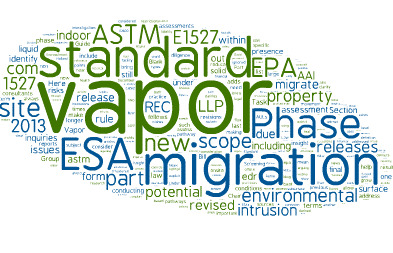Half a dozen times in the past week, someone asked me “Where does the new Phase I ESA standard address vapor?”
Here’s my answer:
The ASTM Task Group revised the Phase I ESA standard to bring the language in E1527 in line with CERCLA law, which does not differentiate by form of contamination (i.e., soil, liquid/groundwater or vapor). Three specific sections of the E1527-13 standard address vapor risk:
1. Section 3.2.2 adds the words soil vapor to the definition of “activity and use limitations” as follows:
AULs are defined as “legal or physical restrictions or limitation on the use of, or access to a site or facility: (1) to reduce or eliminate potential exposure to hazardous substances or petroleum products in the soil, soil vapor, groundwater and/or surface water on the property…”
2. Section 3.2.56 adds a new definition of migrate/migration as follows:
For the purposes of this practice, “migrate” and “migration” refers to the movement of hazardous substances or petroleum products in any form, including, for example, solid and liquid at the surface or subsurface, and vapor in the subsurface.”
3. Section 13.1.5.7 (and X5.8) clarifies that “indoor air quality” is a non-scope consideration only if it is unrelated to releases of hazardous substances or petroleum products.
Section 2.1 also references the ASTM E 2600 Guide for Vapor Encroachment Screening Standard.
Despite the new language, there is still confusion out there about whether a vapor assessment needs to be part of a Phase I ESA scope under E1527-13. Part of the problem, noted ASTM Task Group Chair Julie Kilgore in a webinar with LightBox EDR® in October is the tendency to use the terms “vapor intrusion” and “vapor migration” interchangeably. The distinction between the two terms is an important one. It is not within the scope of a Phase I ESA to evaluate the potential for vapor to be present inside a building as the result of a release (vapor intrusion), but it is within the scope to identify the presence or likely presence of hazardous substances or petroleum products on the property due to a release, based on an understanding of the various pathways and how contamination is likely to migrate on to the property.
Shortly after ASTM published the E1527-13 standard, the U.S. EPA issued its final rule, Amendment to Standards and Practices for All Appropriate Inquiries Under CERCLA, on December 30, 2013 to formally recognize ASTM E1527-13 as AAI-compliant. In the final rule, it is worth noting that the U.S. EPA uses the term “vapor migration” or “vapor releases” 11 times to make points like these:
“EPA believes that ASTM E1527-13 improves upon the previous standard and reflects the evolving best practices and level of rigor that will afford prospective property owners necessary and essential information when making property transaction decisions and meeting continuing obligations under the CERCLA liability protections. In particular, the new ASTM E1527-13 standard enhances the previous standard with regard to the delineation of historical releases or recognized environmental conditions at a property and makes important revisions to the standard practice to clarify that all appropriate inquiries and phase I environmental site assessments must include, within the scope of the investigation, an assessment of the real or potential occurrence of vapor migration and vapor releases on, at, in or to the subject property [NOTE: bold added by the author for emphasis].”
“EPA wishes to be clear that, in its view, vapor migration has always been a relevant potential source of release or threatened release that, depending on site-specific conditions, may warrant identification when conducting all appropriate inquiries. EPA applauds the revisions made by ASTM International to the updated E1527-13 standard regarding vapor migration. EPA anticipates that practitioners properly conducting all appropriate inquiries will consider all conditions indicative of releases and threatened releases of hazardous substances and that the revised standard will help reduce previous confusion on how to conduct a thorough all appropriate inquiries investigation.”
After a thorough read of the final rule, it is difficult for any professional to argue that an assessment of vapor migration risk is not part of an AAI-compliant Phase I ESA. Still not convinced? Consider this: Law firms across the country have issued briefs in response to E1527-13 and EPA’s final rule to advise clients to switch to the new protocol immediately and to stress the importance of including vapor migration in the scope of a Phase I ESA. Here are a few recent examples:
“CERCLA and the AAI rule do not allow environmental professionals to overlook the vapor migration pathway and simply consider contamination in the soil and groundwater in making a determination about the presence of RECs in, on or at a property.” Attorney Bill Wagner
“No longer can vapor risk be ignored, delayed or downplayed. Plenty of attorneys are out there arguing that vapor should have always been part of a CERCLA-driven Phase I ESA.” Attorney David Gillay at Barnes & Thornburg
“Currently, potential vapor migration, which is not explicitly addressed in E1527-05, is not consistently assessed as part of Phase I ESAs. By including this explicit reference to migration in E1527-13, the standard clarifies that the potential for vapor migration should be addressed as part of a Phase I ESA and should be considered a REC when identified.” Holland & Knight LLP
“Because ASTM E1527-05 excludes consideration of indoor air quality concerns, vapor intrusion risks have typically been absent in Phase I ESA reports. However, under E1527-13, environmental professionals will need to assess possible indoor air quality impacts from vapor intrusion pathways if there is surface soil or groundwater contamination at or near the subject property. As a result, Phase I ESA reports will likely more frequently identify vapor intrusion issues since consultants may no longer use the “indoor air quality” exception to exclude vapor intrusion from the scope of the Phase I ESA.” Bingham Greenebaum Doll LLP
“Under the revised ASTM E1527-13 standard, the terms “migrate” and “migration” are specifically defined to include the movement of hazardous substances in any form, including solid, liquid, and vapor. In other words, vapor intrusion is considered a potential pathway of contamination just like groundwater and soil. Moreover, the revised standard provides that environmental consultants should assess vapor migration using the ASTM E2600-10 standard, the “Standard Guide for Vapor Encroachment Screening on Property Involved in Real Estate Transactions,” or another appropriate alternative methodology. Therefore, environmental consultants conducting Phase I environmental site assessments must now determine the potential for vapors to migrate through pathways from both onsite and offsite sources and, if such a potential exists, identify it as a REC. Blank Rome LLP
At our fall Due Diligence at Dawn sessions, we had lenders in every city from institutions like SunTrust, U.S. Bank, CapitalOne and others sharing their responses and reactions to the new language. In many cases, the risk managers noted that vapor is not a new consideration. Rather, they have been requiring vapor migration assessments as a standard part of their Phase I ESAs for years due to the risk that vapor presents.
***
ASTM. The U.S. EPA. Risk managers at financial institutions. Attorneys. The list of sources recognizing that vapor migration risk should be a routine part of environmental due diligence continues to expand. The latest developments leave little doubt that standard practice recognizes that vapor is a risk under CERCLA and should be addressed along with soil and groundwater contamination.

